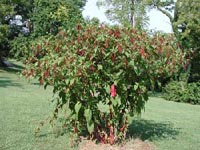Resource Library
Plant of the Week: Pokeweed (Pokeberry)
The University of Arkansas System Division of Agriculture does not promote, support or recommend plants featured in "Plant of the Week." Please consult your local Extension office for plants suitable for your region.
Plant of the Week
Pokeweed, Pokeberry
Latin: Phytolacca americana

In April 2000, a rural tradition slipped quietly into the past with few noticing and still fewer caring. Allen Canning Company of Siloam Springs canned its last batch of poke sallet greens. From now on you will have to gather your own if the craving for poke greens overtakes you as the brown beans simmer in the pot.
What is pokeweed?
Pokeberry or pokeweed, Phytolacca americana, is a ubiquitous weed from Maine to Miami to Mexico, so not surprising our forefathers found a use for it, in fact several uses. It is a stout herbaceous perennial that, in good soil, can form a thigh-size taproot. The taproot is poisonous and there are reports of careless gardeners mistaking poke roots for horseradish roots with dire consequences. Native Americans used poke roots as a laxative and an emetic.
From the crown of the plant emerge leafy, asparagus-like shoots that are edible during the first days of spring. If these smooth, purple-tinged shoots are allowed to grow they can reach six to 10-feet tall with a comparable spread.
By midsummer, plants begin producing six-inch long racemes of greenish white apetalous flowers. The flowers give rise to juicy, pea-size berries that transition from green to pink to dark purple. Flowering continues until frost with plants having flowers and berries at the same time. The berries are a favorite food for berry-eating songbirds.
Where does the name come from?
Poke gets its name from an Indian word "pokan" which means any plant used to produce a red or yellow dye. It even has a political connection. Leaves of pokeberry were worn on the lapels of supporters of the first dark-horse candidate for president, James Polk who served from 1845 to 1849 and for whom Polk County is named.
Arkansas' history with pokeweed is lengthy.
Pokeweed enjoyed a good reputation across the south as a spring green because it was one of the first edible herbs to appear, giving a much-needed break from the beans, cornbread and salt pork diet of winter. As Arkansas hill folk gave up the land during the Depression and moved away, they took with them the taste for pokeweed.
Arkansas processors have canned poke commercially since at least the middle years of the last century. It has always been wild-harvested even though Dr. John Bowers, a former colleague in the horticulture department, made efforts in the 1950’s to turn pokeweed into a legitimate vegetable. As late as 1990 at least two processing plants continued the tradition, Bush Brothers of Tennessee and Allen of Siloam Springs.
Surprisingly, one of the best markets for canned poke sallet was California. Delbert Allen speculated in a 1989 article that the California market is an echo from past Dust Bowl and Depression era emigrants attempting to reconnect with their roots. But, times change. People get old and die.
John Williams, the canning supervisor at Allen Canning, says "The decision to stop processing poke was primarily because of the difficulty of finding people interested in picking poke and bring it to our buying locations." Also, poke processing was never a significant item in their multimillion-dollar enterprise, so it just became more bother than it was worth.
How do you eat pokeweed?
Poke is primarily eaten in the same way as other spring greens, but some peel and fry the stalks much as done with okra pods. A good poke green recipe calls for a large batch of green leaves to be parboiled for three minutes then drained, parboiled a second time and then drained again and cooked until tender. Fry three strips of bacon, a chopped green onion and then add the drained greens. Get this hot and then add four eggs for scrambling.
The leaves are collected early in the spring and they are cooked and the liquor poured off of the leaves. This process in repeated three times at least. This will remove most of the toxin although the salad (sallet in Arkansas) was considered a spring tonic to clean out all the bad stuff accumulated in the body over the winter even after the processing. No one should ever eat the berries or unprocessed leaves. The leaves must be processed before cooking and the leaves must be collected only early in the year
By: Gerald Klingaman, retired
Extension Horticulturist - Ornamentals
The University of Arkansas System Division of Agriculture does not maintain lists of retail outlets where these plants can be purchased. Please check your local nursery or other retail outlets to ask about the availability of these plants for your growing area.